
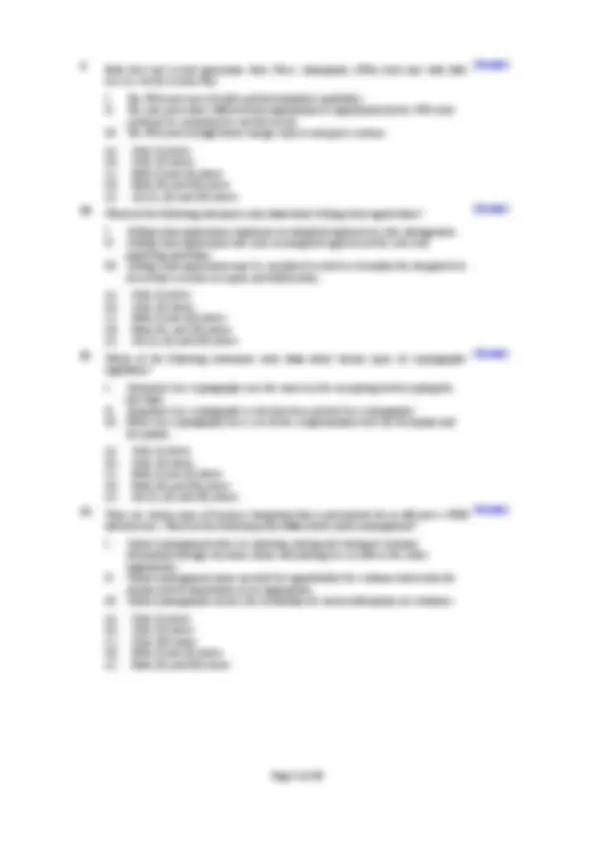
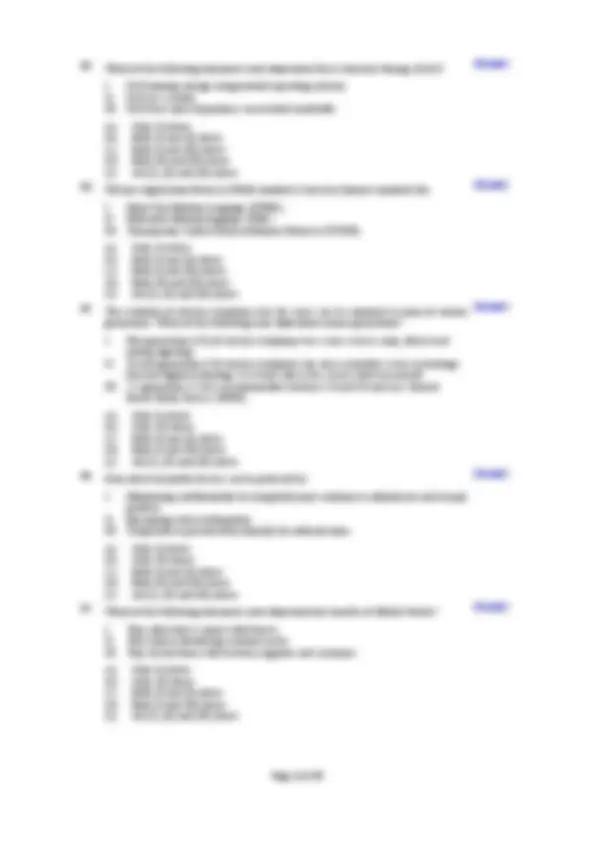
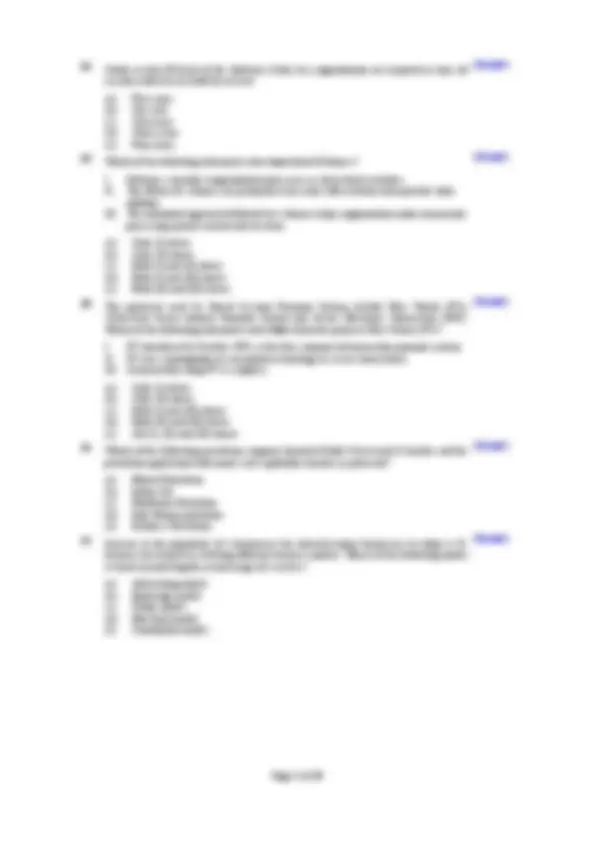
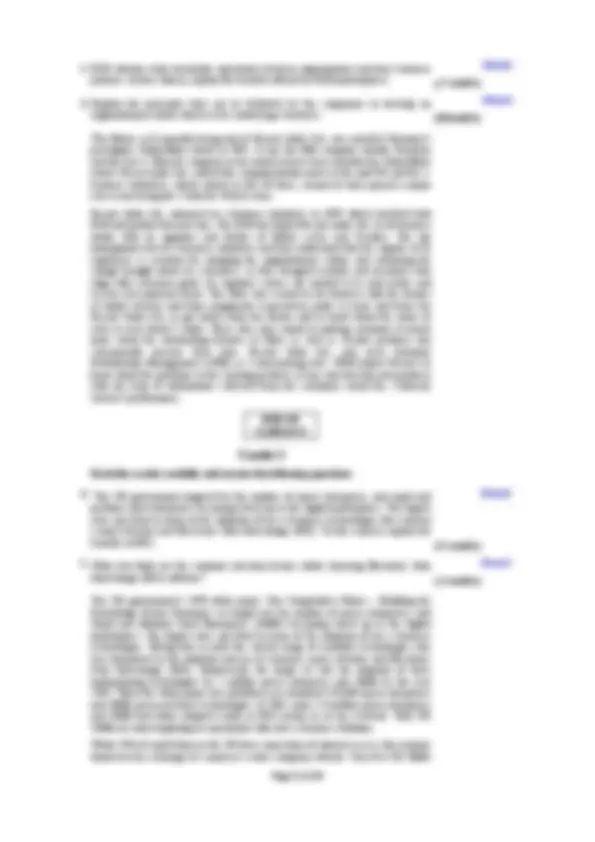
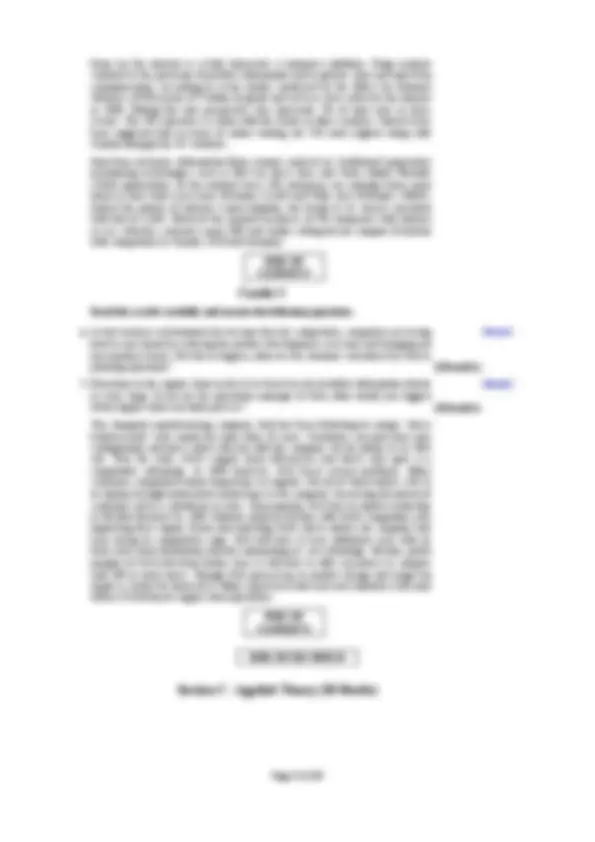

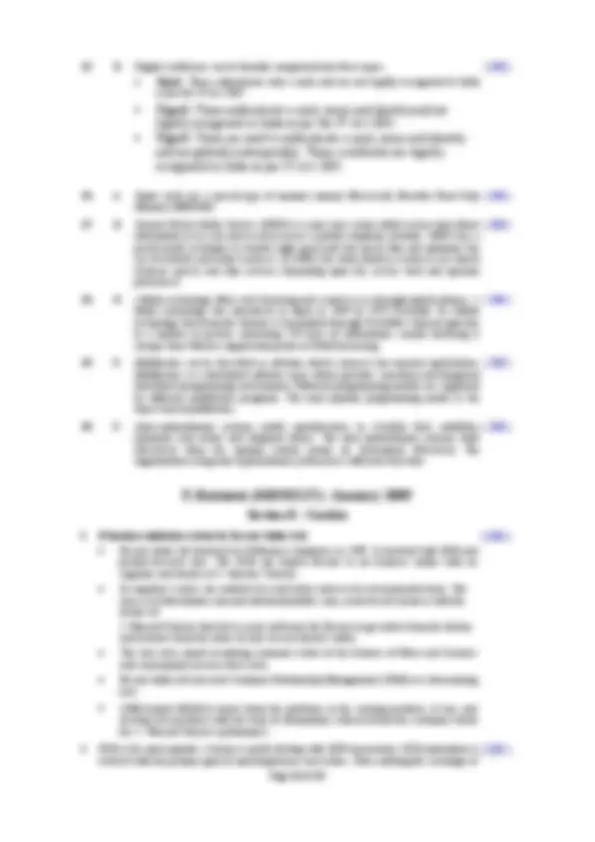
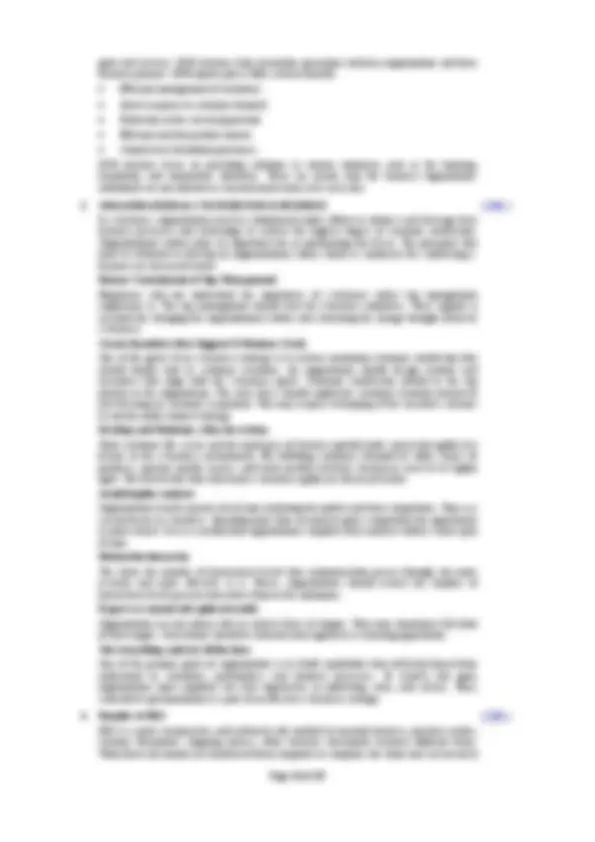





Study with the several resources on Docsity

Earn points by helping other students or get them with a premium plan


Prepare for your exams
Study with the several resources on Docsity

Earn points to download
Earn points by helping other students or get them with a premium plan
Community
Ask the community for help and clear up your study doubts
Discover the best universities in your country according to Docsity users
Free resources
Download our free guides on studying techniques, anxiety management strategies, and thesis advice from Docsity tutors
jhlIcfai E-buisness Module 1 - jan 2009
Typology: Exams
1 / 19

This page cannot be seen from the preview
Don't miss anything!












sequence of steps?
I. Provide e-catalog. II. Determine price. III. Configure solution. IV. Check inventory. V. Accept order. VI. Order tracking. VII. Process order. VIII. Payment.
(a) I-II-III-IV-V-VI-VII-VIII (b) I-III-II-IV-V-VII-VI-VIII (c) I-III-II-V-IV-VII-VI-VIII (d) I-II-III-V-IV-VII-VI-VIII (e) I-III-II-V-IV-VI-VII-VIII.
2. (^) When designing a website for selling goods and services, a seller should ensure that the
site contains various components. Which of the following component is a special-purpose software that enables users to define a product that meet their needs, access information about products, compare prices and purchase them without the assistance of experienced personnel?
(a) Bundling (b) Entrust (c) Configurator (d) Tapping (e) Tying.
3. (^) Suppliers may be classified into various categories depending on the type of components
they supply. Which of the following does not come under the classification?
(a) Suppliers of scarce products (b) Suppliers of strategic products (c) Suppliers of non-strategic products (d) Suppliers of commodity products (e) Suppliers of integration products.
4. (^) Which of the following is/are true about Internet Protocol Version4 (IPV4) and Internet
Protocol Version6 (IPV6)?
I. IPV4 uses 16-bit addresses. II. IPV6 uses 32-bit addresses. III. IPV6 uses hexadecimal system for denoting the address.
(a) Only (I) above (b) Only (III) above (c) Both (I) and (II) above (d) Both (II) and (III) above (e) All (I), (II) and (III) above.
i.exe
5. (^) Transferring a business into an e-business model requires the formulation of a strategy
and framework for applying the strategy. The formulation of an e-business strategy includes
I. Knowledge building. II. Capability evaluation. III. E-business design.
(a) Only (I) above (b) Both (I) and (II) above (c) Both (I) and (III) above (d) Both (II) and (III) above (e) All (I), (II) and (III) above.
6. (^) Partnerships are essential because no company can perform well in all areas of businesses.
The primary requirements for developing a partnership plan for an e-marketplace are
I. Defining the e-value chain requirements of business and customers. II. Identifying the partnership candidates. III. Determining the degree of ownership that the company is willing to forego. IV. Defining a non preemptive strike strategy.
(a) Both (I) and (II) above (b) (I), (II) and (III) above (c) (I), (II) and (IV) above (d) (II), (III) and (IV) above (e) All (I), (II), (III) and (IV) above.
7. (^) Each area of Operating Resources Management (ORM) and the requirements of
employees, buyers and suppliers should be considered in the design of e-procurement application. The integration of e-procurement is complete, when
I. Suppliers are able to achieve cost efficiency and speedy delivery. II. Professional purchasers are able to control purchase processes in the organization, manage effective supplier relations, reduce costs and increase efficiency. III. Employees find it convenient and easy to use.
(a) Only (I) above (b) Both (I) and (II) above (c) Both (I) and (III) above (d) Both (II) and (III) above (e) All (I), (II) and (III) above.
8. (^) Which of the following statements are true about supply chain management?
I. Supply chain management is a set of processes which helps organizations develop and deliver products. II. Supply chain management can help companies integrate their customers, suppliers and channel partners. III. Supply chain management also involves the integration of adhoc and fragmented processes into a consolidated system. IV. Supply chain links all the activities only in procurement.
(a) Both (I) and (II) above (b) Both (III) and (IV) above (c) (I), (II) and (III) above (d) (II), (III) and (IV) above (e) All (I), (II), (III) and (IV) above.
13. (^) Which of the following statements is/are true about Direct Attached Storage (DAS)?
I. DAS manage storage using network operating systems. II. DAS are scalable. III. DAS have much dependence on network bandwidth.
(a) Only (I) above (b) Both (I) and (II) above (c) Both (I) and (III) above (d) Both (II) and (III) above (e) All (I), (II) and (III) above.
14. (^) Wireless Application Protocol (WAP) standard is based on Internet standards like
I. HyperText Markup Language (HTML). II. Extensible Markup language (XML). III. Transmission Control Protocol/Internet Protocol (TCP/IP).
(a) Only (I) above (b) Both (I) and (II) above (c) Both (I) and (III) above (d) Both (II) and (III) above (e) All (I), (II) and (III) above.
15. (^) The evolution of wireless telephony over the years can be examined in terms of various
generations. Which of the following is/are true about various generations?
I. First generation (1G) of wireless telephony was a voice service only, which used analog signaling. II. Second generation (2G) wireless telephony was also essentially a voice technology but used digital technology. It is faster due to the circuit switch-on and off. III. 2.5 generation (2.5G) is an intermediate between 2G and 3G and uses General Packet Radio Service (GPRS).
(a) Only (I) above (b) Only (II) above (c) Both (I) and (II) above (d) Both (I) and (III) above (e) All (I), (II) and (III) above.
16. (^) Data stored on mobile devices can be protected by
I. Maintaining confidentiality by using third-party solutions to authenticate and encrypt products. II. Encrypting critical information. III. Using built-in password functionality for authentication.
(a) Only (I) above (b) Only (II) above (c) Both (I) and (II) above (d) Both (II) and (III) above (e) All (I), (II) and (III) above.
17. (^) Which of the following statements is/are true about the benefits of Mobile Portals?
I. They allow direct contact with buyers. II. They help in identifying customer needs. III. They do not form a link between suppliers and customers.
(a) Only (I) above (b) Only (II) above (c) Both (I) and (II) above (d) Both (I) and (III) above (e) All (I), (II) and (III) above.
18. (^) Under section 802(a)(i) of the Sarbanes-Oxley Act, organizations are required to store all
records related to an audit for at least
(a) Five years (b) One year (c) Two years (d) Three years (e) Four years.
19. (^) Which of the following statements is/are true about E-finance?
I. E-finance considers organizational processes as interrelated activities. II. The efforts of e-finance are primarily to do away with activities that provide value addition. III. The automated approach followed by e-finance helps organizations make transaction processing quicker and devoid of errors.
(a) Only (I) above (b) Only (II) above (c) Both (I) and (II) above (d) Both (I) and (III) above (e) Both (II) and (III) above.
20. (^) The protocols used by Stored Account Payment System include First Virtual (FV),
CyberCash Secure Internet Payment System and Secure Electronic Transaction (SET). Which of the following statements is/are false about the protocol First Virtual (FV)?
I. FV introduced in October 1994, is the first commercial transaction payment system. II. FV uses cryptography or encryption technology to secure transactions. III. A transaction using FV is complex.
(a) Only (I) above (b) Only (II) above (c) Both (I) and (III) above (d) Both (II) and (III) above (e) All (I), (II) and (III) above.
21. (^) Which of the following petroleum company launched India’s first retail & loyalty card for
petroleum application with smart card capabilities known as petrocard?
(a) Bharat Petroleum (b) Indian Oil (c) Hindustan Petroleum (d) Indo Burma petroleum (e) Reliance Petroleum.
22. (^) Increase in the popularity of e-businesses has attracted many businesses to adopt it. E-
business has helped in evolving different business models. Which of the following model is based on metering the actual usage of a service?
(a) Advertising model (b) Brokerage model (c) Utility model (d) Merchant model (e) Community model.
28. (^) Which of the following statements is/are false about i-mode technology?
I. i-mode technology offers web browsing and e-mail access through mobile phones. II. i-mode technology was introduced in Japan in 1999 by NTT DoCoMo. III. In i-mode technology data from the Internet is transmitted through DoCoMo’s Internet gateway to a handset in packets containing 128 bytes of information. IV. i-mode browsing is costlier than Wireless Application Protocol (WAP) browsing.
(a) Only (I) above (b) Only (IV) above (c) Both (I) and (III) above (d) Both (II) and (III) above (e) Both (III) and (IV) above.
29. (^) Which of the following statements are true about Middleware?
I. Middleware can be described as software which connects two separate applications. II. Middleware is a distributed software layer which provides consistent and integrated distributed programming environment. III. Different programming models are supported by different middleware programs. IV. The most popular programming model is the event based middleware.
(a) Both (I) and (II) above (b) Both (I) and (III) above (c) Both (I) and (IV) above (d) (I), (II) and (III) above (e) All (I), (II), (III) and (IV) above.
30. (^) Wherever the inventory level fall below the predetermined levels, the machines
automatically place the order and replenish the stock. Which of the following statements is/are true about Auto-replenishment system?
I. Auto-replenishment systems enable manufacturers to schedule their workflow, minimize rush orders and shipment delays. II. The Auto-replenishment systems work effectively when the optimal reorder points are determined effectively. III. The organizations using Auto-replenishment system will not have sufficient lead- time.
(a) Only (I) above (b) Only (II) above (c) Only (III) above (d) Both (I) and (II) above (e) All (I), (II) and (III) above.
Read the caselet carefully and answer the following questions:
1. Mention the various e-business initiatives taken by Escorts India Ltd., a leading two wheeler manufacturing company. (^) ( 3 marks)
2. B2B websites help streamline operations between organizations and their business partners. In this context, explain the benefits offered by B2B marketplaces. (^) ( 5 marks)
3. Explain the principles that can be followed by the companies to develop an organizational culture which is for conducting e-business. (^) ( 10 marks)
The Motor cycle manufacturing unit of Escorts India Ltd., was awarded Germany’s prestigious GilzerMann award in 2001. It was the fifth company outside Germany and the first 2-Wheeler company in the world to have been awarded the GilzerMann award. Escort India Ltd., started the computerization move in the mid 90s and the e- business initiatives, which started in late 90 have, seemed to have played a major role in increasing the 2-wheeler Vehicle sales.
Escorts India Ltd., launched its e-business initiatives in 1999 which involved both B2B and product-focused sites. The B2B site helped Escorts India Ltd., to do business online with its suppliers and dealers of Motor cycles and Scooters. The top management led all e-business initiatives and they understood that the support of its employees is essential for changing the organizational culture and sustaining the change brought about by e-business, so they designed rewards and incentives that align with e-business goals. Its suppliers centric site enabled it to send orders and receive raw materials faster. The other sites created to do business with the dealers of utility vehicles and farm equipments respectively, made it easier and faster for Escorts India Ltd., to get orders from the dealers and to know about the status of sales at each dealer’s outlet. These sites were aimed at making customers to know more about the outstanding features of Bikes as well as Scooter products and consequently increase their sales. Escorts India Ltd., also used Customer Relationship Management (CRM) as a data-mining tool. CRM helped Escorts to know about the problems in the existing products, if any, and develop new products with the help of information collected from the customers about the 2-wheeler vehicle’s performance.
END OF CASELET 1
Read the caselet carefully and answer the following questions:
4. (^) ‘The UK government targeted for the number of micro enterprises, and small and
medium sized enterprises becoming wired up to the digital marketplace. The targets were specified in terms of the adoption of key e-business technologies like external e-mail, websites and Electronic Data Interchange (EDI).’ In this context, explain the benefits of EDI. (^) ( 8 marks)
5. (^) What you think are the common selection factors while choosing Electronic Data
Interchange (EDI) software? (^) ( 4 marks)
The UK government’s 1998 white paper ‘Our Competitive Future – Building the Knowledge Driven Economy’ set targets for the number of micro enterprises, and Small and Medium Sized Enterprises (SMEs) becoming wired up to the digital marketplace. The targets were specified in terms of the adoption of key e-business technologies. Taking into account the current range of available technologies, this was interpreted as the adoption and use of external e-mail, websites and Electronic Data Interchange (EDI). Numerically, the target set was for adoption of these underpinning technologies by 1 million micro enterprises and SMEs by the year
While 70% of small firms in the UK have some form of internet access, this remains limited to the exchange of e-mails or a static company website. Very few UK SMEs
9. Explain the various components which are essential while implementing Customer Relationship Management (CRM). ( 10 marks)
Answer Reason
1. C In e-buying, various steps are to be carried. Hence the correct sequence of steps is
Provide e-catalog –Configure solution – Determine price – Accept order – Check inventory – process order – Order tracking –Payment.
< TOP >
2. C Configurator component is special-purpose software that enables users to define a product that meet their needs, access information about products, compare prices and purchase them without the assistance of experienced personnel.
< TOP >
3. E Suppliers of integration products do not come under the classification depending on the type of components they supply.
< TOP >
4. B IPV6 uses hexadecimal system for denoting the address. < TOP > 5. E Transferring a business into an e-business model requires the formulation of a strategy and framework for applying the strategy. The formulation of an e-business strategy includes I. Knowledge building. II. Capability evaluation. III. E-business design.
< TOP >
6. B Partnerships are essential because no company can perform well in all areas of businesses. The primary requirements for developing a partnership plan for an e- marketplace are I. Defining the e-value chain requirements of business and customers. II. Identifying the partnership candidates. III. Determining the degree of ownership that the company is willing to forego. IV. Defining a preemptive strike strategy.
< TOP >
7. E (^) • Suppliers are able to achieve cost efficiency and speedy delivery.
< TOP >
8. C^ Supply Chain Management (SCM) is a set of processes which helps organizations develop and deliver products.SCM can help companies integrate their customers, suppliers and channel partners.SCM also involves the integration of adhoc and fragmented processes into a consolidated system. Supply chain links all the activities in procurement, transformation and storage of raw materials and intermediate products and the sale of finished goods.
< TOP >
9. D^ The sales procedures differed from organization to organization but the sales force automation (SFA) tools could not be customized to suit their needs. The SFA tools brought about changes only in enterprise systems.
< TOP >
10. C Selling-chain applications emphasize an integrated approach to sales management. Selling-chain applications may be considered as tools to streamline the integrated set of activities in order to acquire and fulfill orders. Selling-chain applications take an integrated approach of the sales and marketing operations and the order equisition process.
< TOP >
25. B Digital certificates can be broadly categorized into three types: - Type1: These authenticate only e-mail, and are not legally recognized in India as per the IT Act 2002. - Type2: These authenticate e-mail, name and identity and are
< TOP >
26. A Smart cards use a special type of memory namely Electrically Erasable Read Only Memory (EEROM).
< TOP >
27. B General Packet Radio Service (GPRS) is a non-voice value-added service that allows information to be sent and received across a mobile telephone network. GPRS uses a packet-mode technique to transfer high-speed and low speed data and optimizes the use of network and radio resources. In GPRS, the radio interface resources are shared between speech and data services depending upon the service load and operator preferences.
< TOP >
28. B i-Mode technology offers web browsing and e-mail access through mobile phones. i- Mode technology was introduced in Japan in 1999 by NTT DoCoMo. In i-Mode technology data from the Internet is transmitted through DoCoMo’s Internet gateway to a handset in packets containing 128 bytes of information. i-mode browsing is cheaper than Wireless Application protocol (WAP) browsing.
< TOP >
29. D Middleware can be described as software which connects two separate applications. Middleware is a distributed software layer which provides consistent and integrated distributed programming environment. Different programming models are supported by different middleware programs. The most popular programming model is the object based middleware.
< TOP >
30. D Auto-replenishment systems enable manufacturers to schedule their workflow, minimize rush orders and shipment delays. The auto-replenishment systems work effectively when the optimal reorder points are determined effectively. The organizations using auto-replenishment system have sufficient lead-time.
< TOP >
E.Business (MB3H1IT): January 2009
1. E-business initiatives taken by Escorts India Ltd: - Escorts India Ltd launched its E-Business initiatives in 1999. It involved both B2B and product-focused sites. The B2B site helped Escorts to do business online with its suppliers and dealers of 2- wheeler Vehicles. - Its suppliers' centric site enabled it to send orders and receive raw materials faster. The sites esco2wheelmanu.com and urfavoritemobike.com, created to do business with the dealers of 2-WheelerVehicles that led to easier and faster for Escorts to get orders from the dealers and to know about the status of sales at each dealer's outlet. - The sites were aimed at making customers aware of the features of Bikes and Scooters and consequently increase their sales. - Escorts India Ltd also used Customer Relationship Management (CRM) as a data-mining tool. - CRM helped M&M to know about the problems in the existing products, if any, and develop new products with the help of information collected from the customers about the 2- WheelerVehicles' performance.
2. B2B is the most popular e-business model dealing with B2B transactions. B2B marketplaces evolved with the primary goal of matching buyers and sellers. Thus enabling the exchange of
gods and services. B2B websites help streamline operations between organizations and their business partners. B2B market places offer several benefits:
In e-business, organizations need to continuously make efforts to enhance and leverage their business processes and technology to achieve the highest degree of customer satisfaction. Organizational culture plays an important role in maintaining this focus. The principles that must be followed to develop an organizational culture which is conducive for conducting e- business are discussed below: Ensure Commitment of Top Management Employees will not understand the importance of e-business unless top management emphasizes it. The top management should lead all e-business initiatives. Their support is essential for changing the organizational culture and sustaining the change brought about by e-business. Create Incentives that Support E-Business Goals One of the goals of an e-business strategy is to achieve maximum customer satisfaction that should finally lead to customer retention. An organization should design rewards and incentives that align with the e-business goals. Customer satisfaction should be the top priority in the organization. The sales force should emphasize customer retention instead of just focusing on customer acquisition. This may require revamping of the incentive schemes to suit the multi-channel strategy. Develop and Maintain a Bias for Action Short customer life cycles and the rapid pace of business growth make speed and agility key factors in the e-business environment. For fulfilling customer's demand of wider choice of products, superior quality service, and faster product delivery, businesses need to be highly agile. The four factors that will ensure e-business agility are discussed below. Avoid lengthy analysis Organizations tend to spend a lot of time analyzing the market and their competitors. Time is a crucial factor in e-business. Spending more time on analysis gives competitors the opportunity to move ahead. So it is essential that organizations complete their analysis within a short span of time. Flatten the hierarchy The lower the number of hierarchical levels that communication passes through, the more accurate and more effective it is. Hence, organizations should review the number of hierarchical levels present and reduce them to the minimum. Expect occasional sub-optimal results Organizations are not always able to achieve their set targets. They may sometimes fall short of their targets. Such failure should be tolerated and regarded as a learning opportunity. Test everything and test all the time One of the primary goals of organizations is to build capabilities that will help them better understand its customers, marketplace, and business processes. To achieve this goal, organizations must regularly test new approaches in marketing, sales, and service. Thus, controlled experimentation is a part of an effective e-business strategy.
4. Benefits of EDI
EDI is a quick, inexpensive, and relatively safe method to transmit invoices, purchase orders, customs documents, shipping notices, other business documents between different firms. When these documents are transferred from computer to computer, the delay and cost incurred
important variable to be taken care of. The module also keeps track of -variables such as loading dock space, trailer availability, transportation modes, etc. ERP provides, the necessary support for the SCP modules. With the help of ERP, SCP processes can determine the demand for a product, the raw materials needed for the product, the time taken to manufacture and deliver it, and the inventory stock of the finished goods and raw materials. SCP applications should be flexible enough to accommodate multiple planning strategies like Profitable-to-Promise (PTP), ATP, Capable-to-Promise (CTP), etc. Usually when a customer requires a few changes in the order placed, a lot of variables like pricing, job sequencing, production schedules, transportation schedules are affected. A SCP application records these changes and makes these changes visible to all the people involved in the process. This makes it possible to coordinate the delivery schedules, shipping schedules, promotion schedule, etc. Since it acts as a single information source, different departments can coordinate their activities optimally.
7. The differentiator between sellers in today's competitive business environment is level of efficiency of a firm, leading to cost-effective customer service. It is no longer sufficient for companies to handle inventory efficiently, they need to adopt a customer-centric strategy. Though planning is beneficial to companies in streamlining processes and reducing costs, it does not necessarily deliver benefits to customers if a customer-centric approach is not adopted. Execution in the supply chain needs to be based on all available information details at every stage. There should be no mismatch in this regard for a well-coordinated supply chain. Software applications for Supply Chain Execution (SCE) are commonly used by companies for managing outsourcing agreements. These applications manage assets, inventory, and orders. They are growing in popularity because: - Businesses are trying to optimize coordination with external channel partners, after having maximized internal efficiencies - Since there is a need for external focus, companies feel that enterprise
While using enterprise applications, companies can either focus on warehousing and transportation, or integrate planning systems with other enterprise software. The components of SCE are order planning, production, replenishment, distribution management, reverse distribution and logistics. Order planning Order planning is becoming increasingly complex because of the rise in customer expectations and shorter delivery cycles. Therefore organizations need to develop efficient execution plans. The plans that best satisfy customer needs should be selected keeping in mind the constraints (such as transportation). The selection process should take into consideration supply chain constraints such as inventory availability, production capacity, suppliers' ability to deliver on time and limitations posed by transportation modes (like truck capacity, maximum load for a truck, and availability of downstream resources). Production Modular product designs have facilitated the assembling of products in warehouses. Unlike a few decades ago, today sub-assemblies are procured when products are to be assembled. The time, quantity and location where the sub-assemblies will be required, are determined by the master production schedule and the Manufacturing Resource Planning (MRP) system. Replenishment Production is not restricted to the manufacturing of products; it includes replenishment strategies that help reduce inventory in the supply chain and facilitate product exchange between the channel partners. Timely replenishment of goods in the warehouse is a critical activity so that the risk of returning a customer empty-handed from a store is minimized. Distribution management Distribution management includes all the activities in transporting goods from the manufacturer to distribution center and finally to customers. Distribution management can be streamlined by integrating it with transportation planning and scheduling. Transportation management facilitates delivery, tracking of shipment and access to shipping details. It also supports a set of complex and dynamic requirements like document generation and regulatory
compliance for international trade. Reverse distribution or reverse logistics Products get outdated very fast. Rapid changes in fashion and generous warranties have resulted in a higher rate of return of goods in recent years. Reverse logistics is concerned with goods returned by customers due to dissatisfaction or defects. The goods are either sent back to the manufacturer or disposed off after the money is returned to the customers. It also includes products designed for re-manufacture, hazardous material and reusable packing.
8. The value chain in the wireless industry consists of seven major components. The mobile value chain starts from suppliers of equipments and includes networks, software, and services, finally ending at the consumer . The players are: Equipment Component Manufacturers: They manufacture parts and sub-assemblies that maintain the mobility and utility of mobile devices. The components enhance the technological capability of mobile devices. For example, batteries with longer life and other technical advancements help improve the performance of mobile phones. Wireless Network Infrastructure Providers: These include companies that provide hardware, fiber networks, wireless, communications towers and satellite networks to enable the convergence of the telecommunications and Internet Protocol (IP) networks. These players provide the points of connection that make possible a mobile network. The business transactions of these companies usually comprise hardware sales or leasing to telecom companies. Examples include Alcatel, American Tower, Ericsson, and Motorola, Mobile Device Manufacturers: These companies sell hardware like mobile phones, Personal Digital Assistants (PDAs), handheld PCs and other networking equipment to facilitate mobile applications. The device manufacturers are the customer's gateway to the wireless network. This segment also includes some complementary markets like PCs, semiconductors, servers, and telecommunications service and equipment. These companies sell mobile devices and other hardware directly to the users or network operators. Players in this segment include Handspring, Compaq, HP, and Sun Microsystems.
The Mobile Value Chain
Retention Management
An effective CRM application helps in distinguishing customers based on the number of years of association with the company and the business given by each customer. A Decision Support System (DSS) helps in customer segmentation. A good DSS gathers detailed customer information and helps the organization in understanding their highly profitable customers.
< TOP OF THE DOCUMENT >